
|
|

July 11, 2008
The Big Trip 2007, part X: Southeastern Washington State
It's become an annual tradition here at Tower Site of the Week - load up the tape decks and the DVD recorders and the cameras, line up a bunch of station tours, gather a few friends, and hit the road for as much as two weeks of in-depth exploration of the radio and TV environment in some scenic part of this great nation of ours. Then we come home and share it all with you, in pictures here on fybush.com and in audio (of legal IDs) over at our sister site, tophour.com.
"Big Trip 2007" covered parts of Utah, Wyoming, Idaho, Montana, Washington and Oregon over two weeks in late August and early September.
Day Six - Wednesday, August 29, 2007
A day that started back in Missoula, Montana and continued into Wallace, Idaho and Spokane, Washington found us, by late afternoon, navigating the profound emptiness that is US 195 south of Spokane.
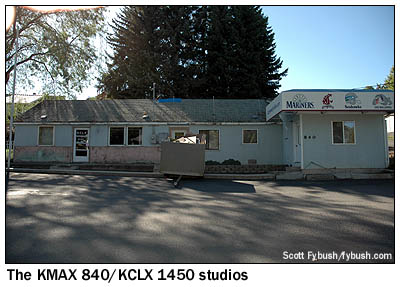
|
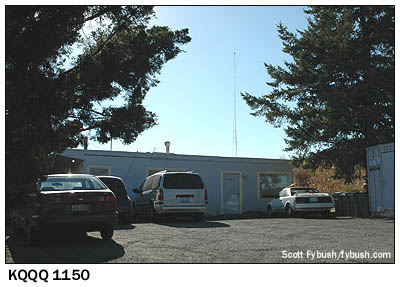
|
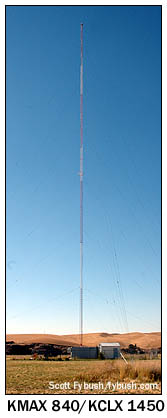
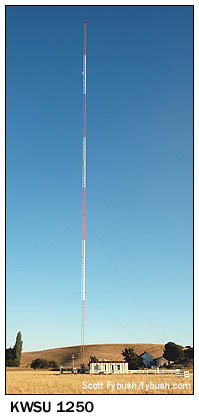 This isn't the Washington
State most people think of - no evergreen forests or tall mountains
here, just mile after mile of rolling desert separating Spokane
from the next set of markets to the south - the paired college
towns of Pullman, Washington and Moscow, Idaho, some 75 miles
south of Spokane, and then the paired paper-mill towns of Lewiston,
Idaho and Clarkston, Washington, another 25 miles or so south
of that.
This isn't the Washington
State most people think of - no evergreen forests or tall mountains
here, just mile after mile of rolling desert separating Spokane
from the next set of markets to the south - the paired college
towns of Pullman, Washington and Moscow, Idaho, some 75 miles
south of Spokane, and then the paired paper-mill towns of Lewiston,
Idaho and Clarkston, Washington, another 25 miles or so south
of that.
There's only one town of any broadcast significance between Spokane and Pullman, and that's Colfax, 15 miles north of Pullman along US 195.
For many years, there was just one radio station here - KCLX (1450), which has been on the air since 1950. But with the breakdown of the clear channels, KCLX gained a sister station. KMAX (840) reaches all the way to Spokane by day, when it's running 10 kW, but at night it drops down to just 280 watts. Both AMs share a tower in the hills northeast of Colfax; their listed studio location just west of downtown didn't seem to have anyone home. (These stations, and FM sister KRAO 102.5, are part of the Inland Northwest group that also has signals in Moscow and Lewiston, as we'll see later in this Site of the Week installment.)
After our quick stop in Colfax, it's a short drive south to the pretty college town of Pullman, where we drive by the studio/tower site of news-talker KQQQ 1150 on Old Wawawai Road - it's also the studio of top 40 "Border 104" KHTR 104.3 - on our way to our one and only tour in these markets. Ralph Hogan, the engineering director for Northwest Public Radio, is one of the legendary engineers in the public radio community, and he's graciously agreed to stick around at the end of the day to give us a tour of the facilities at the Murrow College of Communications at Washington State University. (Yes, that was Murrow's alma mater, way back in the 1920s.)
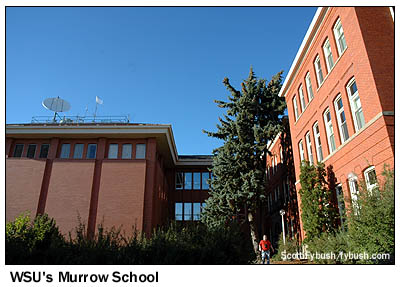
|

|
There was a radio station here even in Murrow's day. KFAE signed on from the campus of then-Washington State College in 1922, becoming KWSC in 1925. Today, it's KWSU (1250), with a transmitter site southwest of Pullman at WSU's agricultural experimental station - and it's the flagship of the Northwest Public Radio system, which programs two networks that stretch from northern Idaho across eastern and central Washington, with more recent station additions picking up service to areas northwest of Seattle, at the other end of the state.
NWPR's studios in the older part of the Murrow building are modest but eminently functional; there's a master control area that handles all the links to and from the network's remote transmitter sites, a control room (shown here) for the NPR news and talk network based at KWSU and another one (across the glass) for the "NPR and classical" network whose flagship is KRFA (91.7 Moscow ID), about which more in a moment.
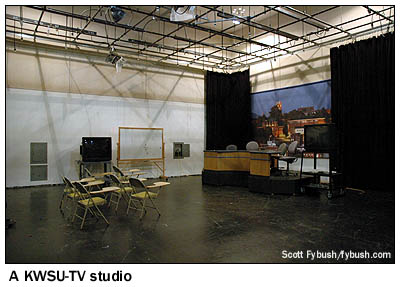
|
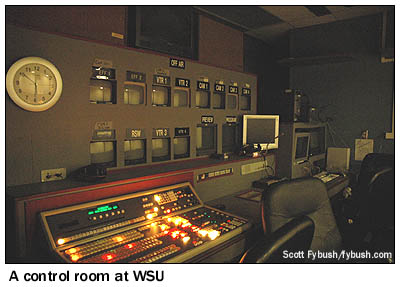
|
It's only eight miles from Pullman over to its sister college town on the Idaho side of the border. Moscow is home to the University of Idaho (making it, we're thinking, the major state university that's most distant from a majority of its own state's population), and it's home to one cluster of commercial signals, owned by Inland Northwest, which we find on a ridge north of downtown. KRPL (1400 Moscow) is the heritage AM here; country KZZL (99.5 Pullman) and top 40 KZFN (106.1 Moscow) are also based here, and the KRPL transmitter is just down the hill.
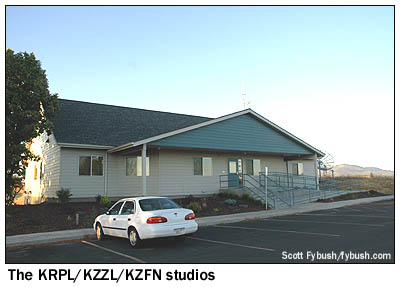
|
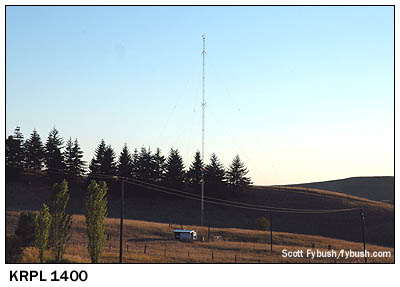
|
The university campus fills up most of the area south and west of downtown, and our first glimpse there is of the student station, KUOI (89.3), transmitting from the top floor of the student union building. KUOI started as a carrier-current AM in 1945, moving to FM in the seventies. The other FM signal on campus, KUID (91.7), had itself begun as a ten-watter in the fifties, but it became a major regional signal in 1965 when it moved to the tower of the university's new TV station, KUID-TV (Channel 12), up on Paradise Ridge southeast of Moscow. During a state funding crunch in the early eighties, money for KUID-FM ran out, and the license was transferred to Washington State University, which now runs it as KRFA.
KUID-TV survives as part of the Idaho Public TV network, though most programming now comes from the main Boise studios instead of the KUID Building at the edge of the U of I campus. (One more curious note about KUID-TV: long before most stations were thinking about shuffling their DTV and analog assignments, it made an early move, putting its DTV signal on channel 12 and bumping analog up to a low-power signal on channel 35 until the end of analog TV next year.)

|
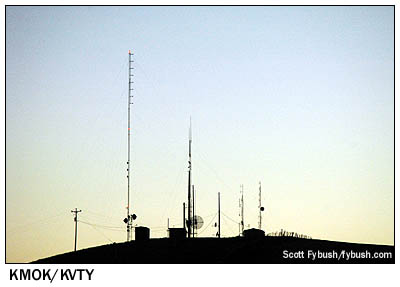
|
By the time we're done with the Moscow stations, it's starting to get close to nightfall as we head south down US 95 toward our overnight stop in Lewiston, 25 miles or so away.
 Lewiston
sits in a dramatic setting at the confluence of the Clearwater
and Snake Rivers, which together form a gorge several hundred
feet below the plateau on which we're driving as we head south.
Just after merging with US 195 (carrying traffic south from Pullman),
95 makes a precipitous drop into the valley, but before it gets
there, we have some towers to see.
Lewiston
sits in a dramatic setting at the confluence of the Clearwater
and Snake Rivers, which together form a gorge several hundred
feet below the plateau on which we're driving as we head south.
Just after merging with US 195 (carrying traffic south from Pullman),
95 makes a precipitous drop into the valley, but before it gets
there, we have some towers to see.
Most of the FM and TV signals that serve Lewiston and neighboring Clarkston, Washington originate from the ridge here. The market's lone commercial TV station, KLEW (Channel 3/DT 32), broadcasts from Stout Ridge a couple of miles west of US 95, along with Northwest Public Radio's KNWV (90.5 Clarkston) and oldies "Cool" KCLK-FM (94.1 Clarkston) and classic rock KVAB (102.9 Clarkston). Top 40 "Cat" KATW (101.5 Lewiston) has its tower next to the visitor information building at the top of the descent on 95; hot AC KVTY (105.1 Lewiston) and country "Outlaw" KMOK (106.9 Lewiston) are on a little outcropping just to the west; and "Z-Rock" KOZE-FM (96.5 Lewiston) sits just alongside 95.
There are actually two routes down into Lewiston from up here - a newer US 95 routing that follows a wide sweep to the east as it heads downhill, and "The Old Spiral," the 1920s-era route full of switchbacks and hairpins that follows a more direct route down into town. We take the old road up, and later that night, after dinner and airchecking (including the KLEW-TV news, which simply repeats its 6 PM show at 11, with an extra five-minute interview at the end to fill the gap before David Letterman comes on), we decide to drive up the new road to see what it's like - and what we can hear from the top of the hill.
This turns out to have been a bad choice. Note the date - near the end of the month - and the fact that we were driving a car with out-of-state plates. And if we haven't mentioned it already, note, too, that Lewiston and surrounding Nez Perce County have fallen on very hard economic times, and apparently they need all the revenue they can get. Sadly, they choose to do so by running speed traps, and yes, we got caught in one as we headed across the US 12 bridge to pick up the new road out of town. (Don't believe it was all about revenue generation? Consider that the local prosecutor was more than happy to plead the charges way down to something that wouldn't affect my insurance or be reported to my home state - as long as I paid them their hundred bucks and change. So we'll call it a cost of doing business, on both sides. And remember - your financial support helps cover these and all the other ever-rising costs of bringing Tower Site of the Week to you. Thanks...)
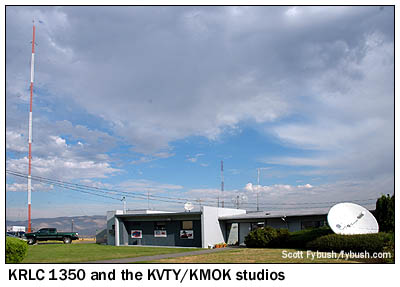
|
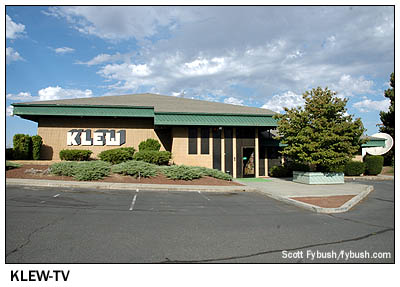
|
Day Seven - Thursday, August 30, 2007
The next morning, we were in no mood to stick around Lewiston much longer than we had to; no doubt there are some nice people there, but there wasn't much more we needed to see, we were in a grumpy state because of the previous night's ticket, we had a lot of miles to get under our wheels on the way to Boise that evening, and did we mention that Lewiston is a paper mill town, with all the odors such operations produce?
So we took a quick spin past the local broadcast facilities south of the river on the way out: Inland Northwest's country KRLC (1350 Lewiston) operates from a two-tower array up on the big hill south of town, with 5 kW non-directional by day, 1 kW directional at night. This building is also home to the KMOK/KVTY studios, and the sign on the door promotes the company's other stations in Moscow/Pullman and Colfax, too. (The Moscow/Pullman and Lewiston/Clarkston areas are close enough that there's lots of signal overlap; indeed, the area is sometimes known as the "Quad Cities," though we reserve that term for the bigger market on the Iowa/Illinois border.)
KLEW-TV, one of the smallest links in the big Fisher Broadcasting chain that stretches across the Northwest, has its studios just west of the KRLC array. As noted above, it's the only commercial TV station based here; technically, this area is considered part of the Spokane market and gets all of that city's signals via cable and translator. (There's a full-power station, KQUP 24, based in Pullman, but it uses an LPTV relay and cable carriage to serve Spokane, originally with UPN and now with Retro TV.)
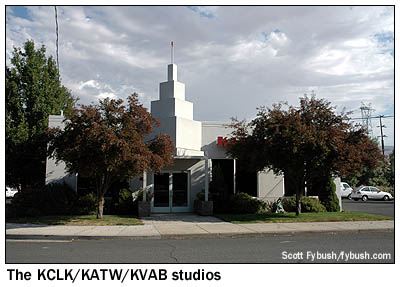
|

|
Downtown Lewiston is pretty desolate on this (and probably every) Thursday morning; there's just one studio stop to make here, at the Pacific Empire Communications studios on C Street, just down the block from the Lewiston Morning Tribune building.
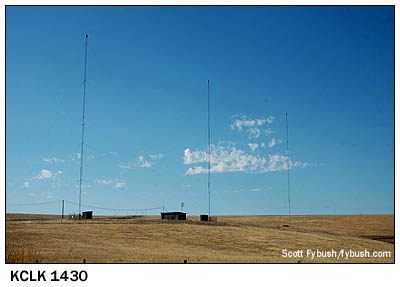 It's
home to sports KCLK (1430 Asotin WA) as well as KATW and KVAB,
and subsequently added a fourth signal in 2008, smooth jazz KQZB
(100.5 Troy ID) - though we note that KCLK is off the air this
particular morning.
It's
home to sports KCLK (1430 Asotin WA) as well as KATW and KVAB,
and subsequently added a fourth signal in 2008, smooth jazz KQZB
(100.5 Troy ID) - though we note that KCLK is off the air this
particular morning.
There's one more site on the Idaho side of the river before we cross over to Washington: talker KOZE (950 Lewiston) and KOZE-FM sit almost on the banks of the Snake River a mile south of downtown. The AM runs 5 kW days, 1 kW nights, with separate directional patterns.
Crossing into Clarkston, there's not much to see in town, so we follow the west bank of the Snake River south for a couple of miles into Asotin, where state route 129 twists and turns up the hill to the three-tower array of KCLK(AM). This is also a 5 kW day/1 kW night DA-2 operation, and whatever's keeping it off the air is apparently being dealt with, since the gate is open and there's a truck there. We don't like bothering engineers when they're in the middle of a crisis, so we snap a few quick pictures from outside, head back up to Clarkston, and point ourselves west on US 12, bound for Walla Walla, Pendleton, La Grande and Baker City before finally hitting Boise many hours later.
We'll be back next week with a whole bunch of interesting eastern Oregon radio, and in the meantime, stop by Tophour.com next Wednesday to hear IDs from these "Quad Cities" - and for heaven's sake, keep the speed down as you're driving through Lewiston. (And if you should ever have to visit the area, there are some fine lodging establishments over on the Washington side of the river, we hear...)
Tower Site Calendar 2008 is almost sold out! Visit the Fybush.com Store now and get your calendar now!
- Previous Site of the Week: Big Trip 2007 Part IX - Spokane, Washington
- In Two Weeks: Big Trip 2007 Part XI - Eastern Oregon
- Site of the Week INDEX!
- How can you help support Site of the Week? Click here!
- Submit your suggestions for a future Site of the Week!
